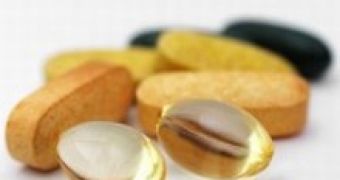Even if most of us consider that we can eat as much fruits, vegetables, foods or take supplements rich in vitamins as we like, because they can only be efficient on our body, the researchers state that excessive amounts of vitamins can be harmful. The cause is the following: some vitamins accelerate the incoming process of the tumors pre-existent in our body and large quantities of vitamins can even lead to heart failure.
This is why the medical institutions have established a daily recommended dose (DRD) for each of the vitamins and minerals in food and supplements.
Vitamin A (retinol) is a powerful antioxidant that contributes to the forming of the pigments in the retina, skin cells and mucous membranes. It maintains the skin healthy, stimulating the general activity of the body and improving eyesight.
It is met in liver, cheese, eggs, fat fish (mackerel), milk, yoghurt. In red fruits and vegetables (carrots, tomatoes, red beet) vitamin A is found as beta-carotene, which is converted by the body in vitamin A.
The DRD is 0,6 mg for women and 0,7 mg for men, while the maximum recommended dose is 1,5 mg per day.
In large amounts, vitamin A can become toxic, causing fatigue, irritability, bone and headaches, nausea. Used by pregnant women excessively can lead to premies or handicapped newly-born children. Taking daily for many years dozes that exceed 1,5 mg can be the starting point for bone fractures and hepatic disorders.
Vitamin B6 helps forming the red blood-cells and is a powerful antioxidant, as well as all the vitamins, in fact. It contributes to the good functioning of the brain and nervous coordination, to the emotional balance, encourages antibodies forming and increases the immunity to infections.
Beef or veal liver (100 mg) covers almost a half of the daily required amount of B6. This is also to be found in: brains, pork, chicken, whole cereals (brown rice), eggs, olives, apples, pears, plums, blueberries, chestnuts, strawberries, quinces, pomelos, lemons, potatoes, soy beans, bananas, nuts, cabbage, celery, spinach, parsley, beans, sardines.
The DRD is 1,2 mg for women and 1,4 mg for men, while the maximum recommended dose is 100 mg per day.
High doses of vitamin B6 (more than 200 mg) can lead to extremities paresthesia, disorder that is medically termed "peripheral neuropathy." In some cases, the effects are irreversible.
Vitamin C is a powerful antioxidant, at all costs needed for maintaining all the body cells healthy. It contributes to the iron absorption in the organic system and increases the immunity to infections.
It is found in all fresh fruits and vegetables, which are excellent sources for vitamin C. The richest fruits are kiwi, underbrush, pepper, broccoli, Brussels sprouts, citruses and parsley leaves.
The DRD is 40 mg, while the maximum recommended dose is 1000 mg per day.
Large amounts of vitamin C can cause stomachaches, flatulency, diarrhea, but these symptoms disappear soon after its administration is over. This vitamin is hidrosoluble and cannot be deposited within our body. Therefore, the possible side effects caused by overdoses are quickly deleted, when the vitamin C is eliminated from the organism.
Beta-carotene protects the body from the negative effects of the free radicals and the skin from the UV radiations. It slows down the aging process and helps preventing the diseases associated with old people.
Beta-carotene belongs to a family of compounds called carotenoids, which are found in yellow, orange and red fruits and vegetables: carrots, melon, apricots, mango fruits, peaches, red peppers, but also in spinach, lettuce or broccoli. The amount of beta-carotene is directly connected to the intensity of the color of these foods.
There is no official indication to the DRD, but the maximum recommended dose is 7 mg.
Excessive administration of beta-carotene supplements was connected with a higher risk of getting ill with lung cancer or cardiovascular diseases when it comes to smokers or alcoholics, but it is possible that the non-smokers or non-alcoholic persons come under the same risk.
Calcium quantity to be found in an adult's body is approx 1,5 kilos. Calcium achieves different tasks, the most important being: mineralizing the bone tissue (bones and teeth), maintaining the cardiac rhythm, coagulating the blood, regulating the acid-basic equilibrium.
Calcium is highly present in milk and dairy products (yoghurt, cheese), beans, nuts, peanuts, olives, egg yolk. In smaller quantities is found in meat, vegetables (parsley, peas, carrots, kohlrabi, celery, lettuce, radish, scallion, but not in spinach), soy beans and all soy products. Calcium is also present in fruits, bread and fish.
The DRD is 800 mg, while the maximum recommended dose is 2,5 g per day.
Too much calcium in the blood leads to several disorders or, more severely, to lethargy, confusion and even coma. This can happen to patients that take high amounts of calcium supplements and alkaline substances in the same time (antacid tablets - against gastritis and ulcer symptoms.)
Vitamin D is essential for the absorption of calcium and phosphorus in the body, as well as for the development and health of our bones, cartilages and teeth.
This vitamin is mainly found in ocean fish, liver and eggs. Vitamin D is also present in some types of whole-cereals or armored cow. Anyway, most of the daily necessary amount of this vitamin is absorbed through the skin once with the solar light. That is why it is better for us to eat very much cod, herring or sardines laden with vitamin D.
The DRD is 5 micrograms; as it is a liposoluble vitamin, we don't' need it every day. Vitamin D excess is stored in the fat cells, and large amounts of it can become dangerous for the body. The maximum recommended dose is 50 mg per day.
Too much vitamin D can sometimes lead to excessive absorption of calcium, which is deposited in the soft tissue, including the arteries, where it produces obturations and even heart blocks. Vitamin D cal also causes debilitations of the bone system and kidneys disorders.
Iron is essential for the red blood cells forming and oxygen carrying to the tissues.
Iron is found in egg yolk, mushrooms, red meat (beef), but also in the green leaved vegetables (spinach, etc.) High amounts of iron - but which are harder to be assimilated by the body - are present in the parsley root, nettles, dry fruits (apricots, figs), whole-cereals (brown rice), potatoes boiled in their own jacket, almonds, nuts.
The DRD is 14,8 mg for women and 8,7 mg for men, while the maximum recommended dose is 17 mg per day.
Overdosing with iron can have severe and irreversible effects: from hepatic disorders to cirrhosis, tachycardia, arthritis (by depositing iron on the knuckles), sterility and impotency. Excessive use of iron leads to constipation, throwing up, abdominal pains and can be fatal in kids.

 14 DAY TRIAL //
14 DAY TRIAL // 






